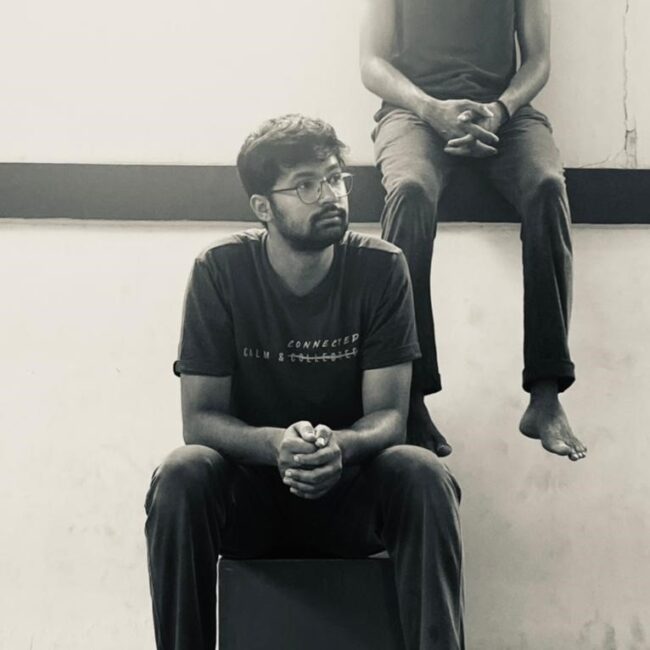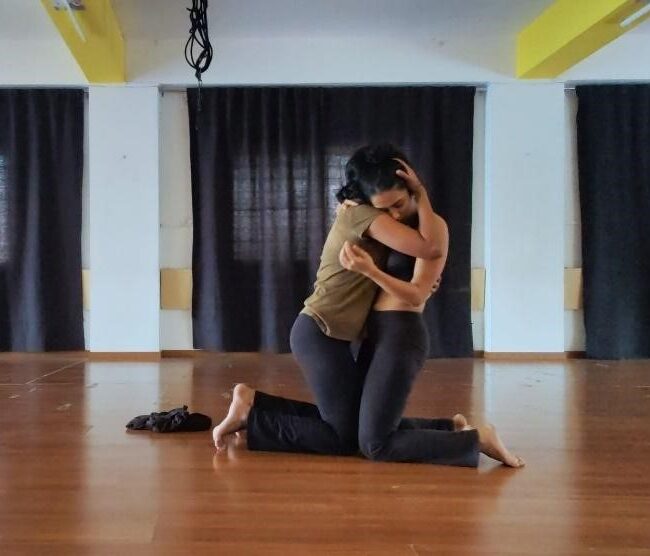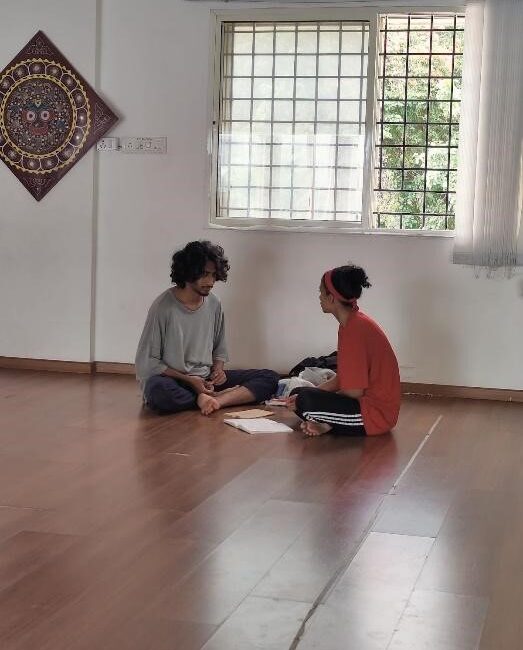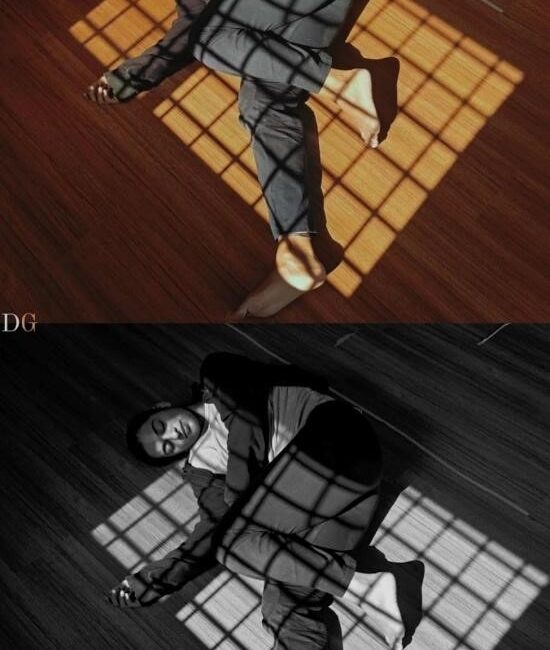The many shades of ‘Black’ – A Conversation with Bangalore based choreographer
Black is the Color, is a piece borne out of “a very personal journey”, as the choreographer Devansh Gandhi would like to put it. It is an “investigation” to understand Devansh’s experiences with sleep paralysis and insomnia, wherein he makes an attempt to answer questions such as- Why does the mind feel trapped? What significance does the color ‘black’ play? Is it always associated with negative experiences? and many more. An ensemble of five dancers- Black is the color comprising movement vocabulary that is influenced by breath patterns, glitches, and light-play, that come together to symbolize the subconscious and its triggers or fears. Black is the Color was performed at Platform 2022 organised by Attakkalari India Biennial 2021-2022 at Ranga Shankara, Bangalore. Devansh started his movement journey in 2016 as a student of Dance Inc India in Ahmedabad. He also did his Diploma in Movement Arts and Mixed media from Attakkalari in 2018-19.
I had been curious to watch this piece because I found its title and its subject very relatable. It had felt almost inevitable for me to analyze the piece through an interaction with Devansh. What uncovered were a series of questions, a deep dive into the world of sleep, choreography, and the endless struggles that one would face while trying to create a full length production during a pandemic. We started the conversation where Devansh expressed the very human tendency of feeling anxious about a zoom interview that would be recorded, even when he had said this with a hearty laughter. I knew at this moment that what was to follow, would be a very genuine and humble expression of his pursuit as a young artist.
When I saw this piece, I felt it said something, and something very important, that must have been lingering in your mind for quite some time.
I’ve had sleep paralysis and insomnia since I was around seventeen years old but during the pandemic the episodes worsened. It was probably because I had taken a break from dancing and working actively with my body. That is actually when I realized that these episodes are deeply connected to my movement or lack thereof. My mind had become overactive and that came in the way of me sleeping, and the days I was mentally exhausted would almost always end up in a sleep paralysis episode. It was at this point that I began to think, if movement is the pathway to healing me, why not use it as a catalyst/vessel. I wanted to create a piece that was ‘art’ and according to me that meant movement supported by music, theatre, and real stories. Music played a very special role. So yes, this was a story that had been lingering in my mind for years.
Given that the experiences you address through this work are so intense and can be troubling for one to recall, how did you work towards creating an environment where you could encourage your dancers to explore with you their own dark memories and mind-spaces?
When we started the piece we were all friends from the start. I also never believed that this journey was solely mine, it was a shared experience (as we all learned through the process) in no way could I have forced my vocabulary or opinions on anyone. I wanted this to be an all immersive space where the whole ‘dancer’ is invited. In the past a lot of us have been asked to keep parts of us shut down in rehearsals, or made to work beyond our bodies’ capacities, this is not the journey I wanted the piece or the dancers to have. What I yearned for was a family and that is how we were. I, with the help of the dancers, managed to create an extremely positive atmosphere where dialogue flowed freely and tantrums were allowed (giggling to himself). Some days were tough and some days not so much, the point is everyone felt supported by each other. I believe that the piece was created in a space of truth and teamwork, in fact I give them more credit for it than myself.
Photo Credits: Devansh Gandhi
Tell me more about the process and the movement vocabulary.
The process started with ‘sharing’. Each dancer had a certain quality that I wanted to delve into and that is exactly what we did. We used to meet at Cubbon Park and each day one dancer would lead the session according to their own unique vocabulary and energy. I very strongly believed that we all had to be immersed in each other’s body languages first and only then was it possible for us to explore and arrive at some collective depths of both mind and body. I also used ‘improvisation’ extensively as a tool. We started some sessions in certain corners of my house because the space seemed most familiar to recreate my experiences. I would ask the dancers to sit in the corners of the room, stare at the wall, imagine certain situations, and see what that did to their bodies, how that made them move. I also worked extensively with sound and vibrations as a tool to trigger movement; this brought out some interesting moments. We spent a lot of time on the dramaturgy of the piece, so that I could bring some theatrical elements into it. Each dancer had to create a character for themselves which would only happen through a much layered process. The dancers were asked to relive experiences from when they ever struggled with their sleep patterns, and that became the core of their characters.
Photo Credits: Devansh Gandhi
Why does the colour ‘black’ hold such an important role in the inspiration for the piece?
In most cultures around the world the colour black holds very negative connotations. For me whenever I had an episode I would always end up in a black room with things or figures moving around me as black shadows. The episodes only happened at night, and so that became another reason for the colour black becoming so important. I also associate most of my depressive episodes and stressful situations with the colour black. I remember when I was younger, oftentimes I used to find myself feeling withdrawn and disconnected from everything around me, and as a result I would often shut myself behind closed doors and windows so I could sit silently in darkness, and almost allow for that black to engulf me. I feel the color black created for me a sense of purpose while making this piece as it fully represents all my episodes and experiences with depression and insomnia.
Photo Credits: Devansh Gandhi
Are there any experiences that you or the dancers had with sleep paralysis or insomnia that you would like to share?
My personal experiences with sleep paralysis or insomnia have been surreal and almost always connected to the lack of movement in my daily life, some of the dancers have also felt the same way. You can’t make someone else really understand how these states of mind feel like, but somehow as we moved deeper into a collective creative process, it seemed like all of us could together unlock memories and stories of sleep that we all had buried.
At this point, Varsha, one of the dancers from the piece, shares her experience.
I would say that I have experienced sleep paralysis at a much lower intensity and the one experience that I do remember vividly is the first one I had ever had. I didn’t even know such an illness existed at that point, it was a very overwhelming experience. The body feels numb and there is absolutely no motion, you quite literally feel ‘paralyzed’ from head to toe, the only thing working is the brain. I could not even figure out whether I was dreaming, was this an illusion or was it reality? This on its own is an extremely stressful feeling. This episode however, wasn’t as intense as I have heard other people share. I was witnessing familiar surroundings and familiar people during this state. I couldn’t move my body, I wanted to scream, and move. My mind was constantly trying to navigate and understand what was happening. It really felt like a mental fight, and it was that sense of fight in my sleep that shook me awake. While creating the piece, we all shared our individual experiences with insomnia and sleep paralysis. It was then that we realized that no two people shared the same experience, everyone’s reactions and responses to their episodes were very different from the other.
What were the struggles you faced as a young choreographer trying to create a full length production during the pandemic?
Well, I am twenty two years old, and I have always felt that time is running out. When the lockdown happened, my sleep issues got worse which gave me the push I needed to create the piece. At first I assumed that this would be a solo piece because it was so personal but as I began to think more, I felt like more bodies might make it relatable and a collective engagement might also help me overcome my mental/emotional struggles. Beyond just personal/psychological struggles, there are many other struggles. We live in a country where all artists are scrounging for funds, space, and venues. So I decided I would turn towards crowdfunding the piece, alongside putting my own savings into it. Thankfully, the crowdfunding worked, I was able to make ends meet and I was okay with that as I had this internal drive that was pushing me forward no matter what. Above everything, I was very much aware that it was under the special circumstances of a lockdown that I was working on the piece! We would practice anywhere we could, inside our homes, in parks, and when the lockdown opened, we started using the studio. As an emerging choreographer I had many constraints that were sure to pull me down, the biggest being my own fears. But I pushed any sense of self-doubt out of the way. After months of hard work, Black is the Colour finally premiered at Bangalore International Centre on the 5th of September and was a successful show.
I share with the reader how I personally felt when I watched the piece and engaged in the above conversation with the dancers.
Trapped like the tangled creeper around the iron fence
I know you, but you seem to fade away into the darkness
Without the black, is there light?
Shadows glimmering and playing
Eyes wide open, lids heavy with disbelief
Without the black, is there light?
Glitch, tremor, twitch, enter
Enter into that endless vortex of black
Without the black, is there light?
I wonder how far the end is.. When does this mayhem stop?
Without the black is there light?
I breathe those breathless breaths
Gulp, swallow, shake my mind up like the peri-peri fries from McDonalds
Without the black, is there light?
And there I lie,
AWAKE, AWAKE, AWAKE
or
TOO ASLEEP
Without the black, IS THERE LIGHT?











